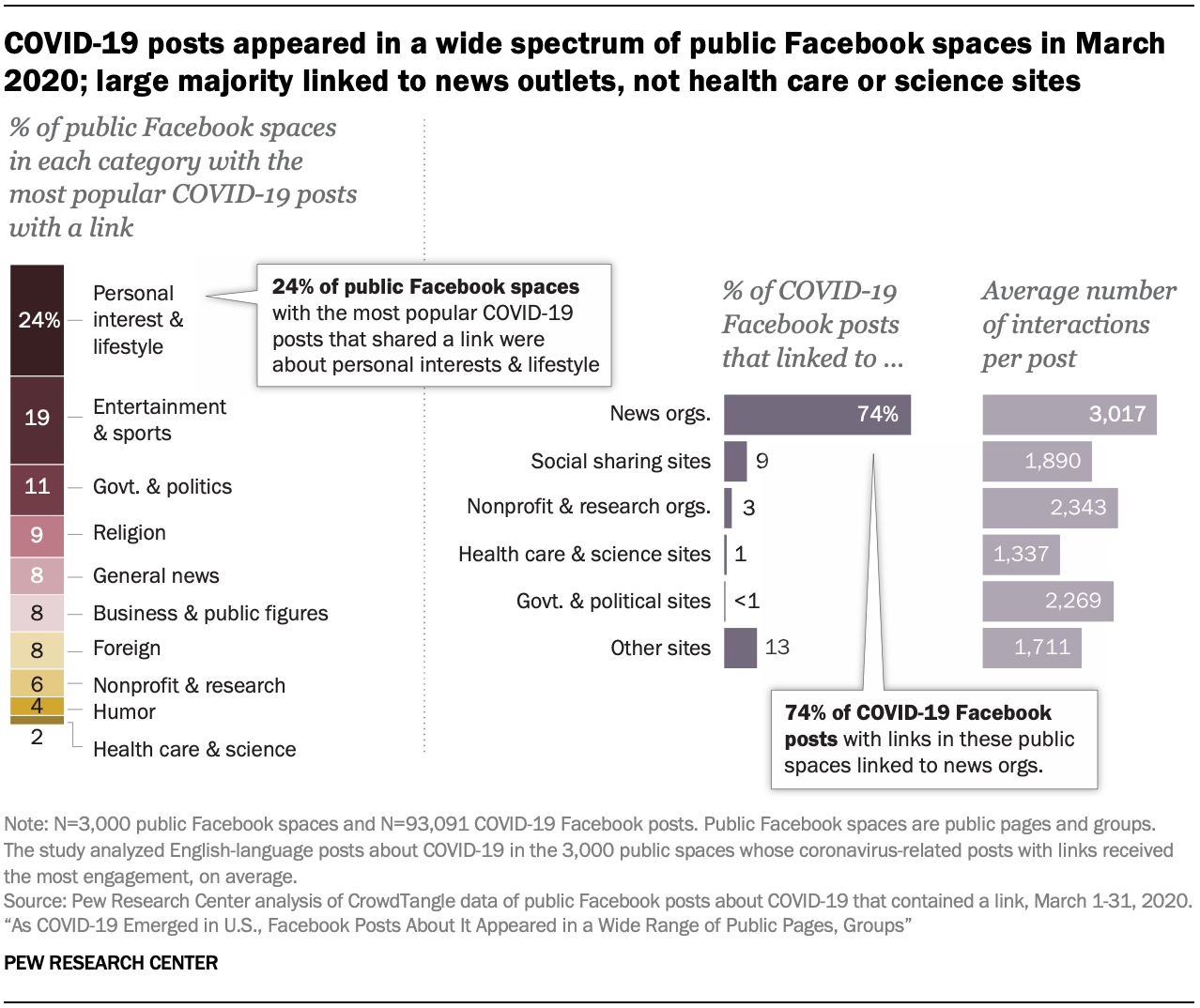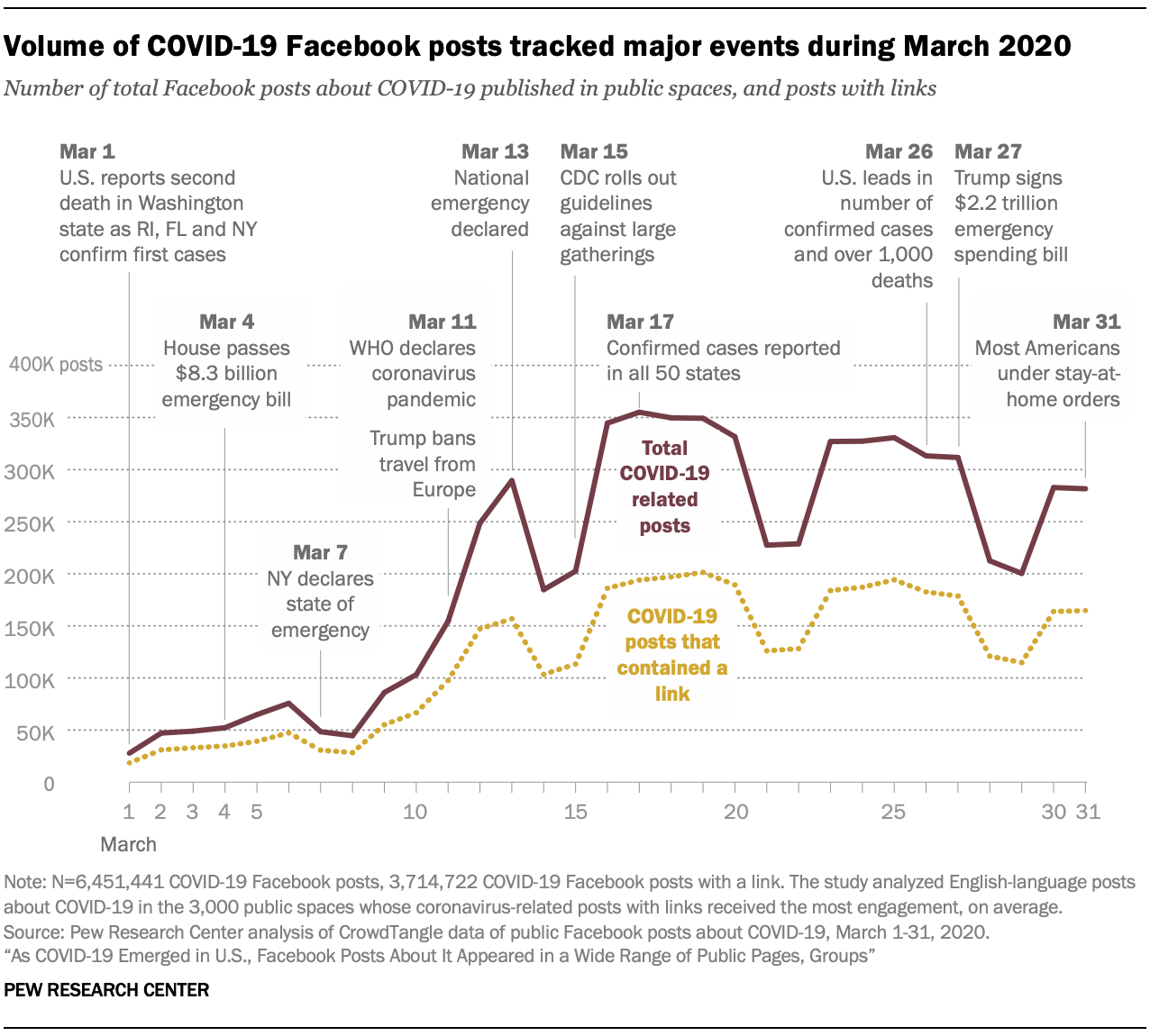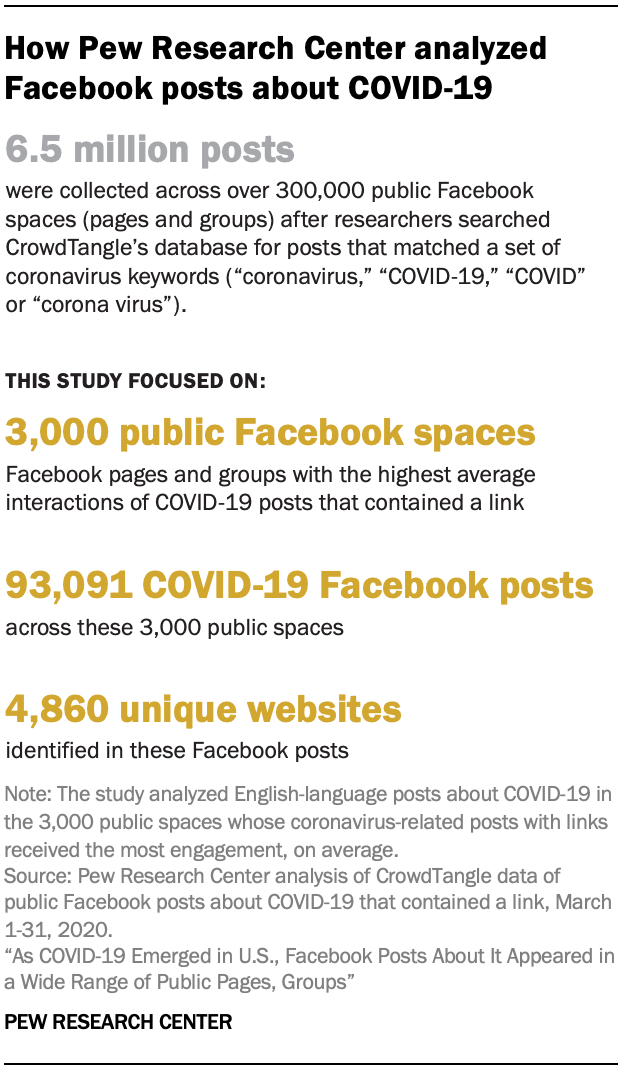This study explored the public spaces (public pages and groups) on Facebook where English-language discussion of COVID-19 occurred during March 2020, as well as the sources Facebook users linked to when posting in these spaces. Taken together, this gives a sense of how widely COVID-19 was discussed as well as the kind of sources users turned to for information about the outbreak. Here are some definitions of key terms used throughout this report:
Public spaces: These are defined in this study as the Facebook pages and groups where posts are public (Facebook distinguishes between pages and groups, but they were combined here). The study analyzed English-language posts about COVID-19 in the 3,000 public spaces (1,500 pages and 1,500 groups) whose coronavirus-related posts with links received the most engagement, on average. Public spaces were coded for their subject orientation and their geographic focus.
Public spaces subject orientation: The different types of public spaces are determined by the main topic the public space is oriented around. Researchers manually categorized public Facebook spaces into 10 categories based on their title and “about” section: 1) personal interest and lifestyle; 2) entertainment and sports; 3) government and politics; 4) religion; 5) general news; 6) business and public figures; 7) foreign; 8) nonprofit and research; 9) humor; and 10) health care and science. For example, a public space called “Informed Parents of California” was classified as personal interest and lifestyle.
Public spaces geographic focus: This indicates whether a public space explicitly referenced a local city, town, neighborhood or state in the U.S.; a foreign country or area; or did not have a geographic focus, including those about the U.S. generally. For instance, the “Informed Parents of California” space had a local focus.
Public posts: These are the English-language coronavirus-related posts with links in the 3,000 public spaces analyzed. Coronavirus-related posts are those that match a set of coronavirus-related keywords (“coronavirus,” “covid-19,” “covid” or “corona virus”). This research identified about 6.5 million Facebook posts published during March 2020 (including those that did not share a link), but the main analysis focused on the 93,091 posts with links about COVID-19 from the 3,000 public spaces, based on the average number of interactions their coronavirus-related posts with a link received.
Interactions: These are the total number of comments, shares, likes and other reactions to these posts. The average coronavirus-related post with a link in this study had 2,713 total interactions.
Sources: These are the websites (e.g. pewresearch.org) that are linked to in these posts (referred to both as sources and sites). The 93,091 Facebook posts analyzed in this study linked collectively to 4,860 distinct websites across the 3,000 public spaces. Sources are coded by source type.
Source type: This describes the different types of websites found at the destination of each link. Researchers manually grouped these into six broad mutually exclusive categories: 1) news organizations, including TV, print and digital; 2) social sharing sites, like blogs and social media; 3) nonprofit and research organizations, including academic institutions and think tanks; 4) health care and science sites, including doctors, hospitals and public health agencies; 5) government and political sites; and 6) all other sites. The study also took a closer look at whether a news organization had a geographic focus – that is, whether it focuses on news in a U.S. city or state, a foreign country, or has no geographic orientation. For example, a local TV news station has a local geographic orientation, while a 24-hour cable news network does not have one.
Research shows that Facebook is a key player in our modern information ecosystem, but understanding what information people are sharing on the giant social media platform is a major challenge. Beyond the fact that what people publish to their own walls and on most pages is private and thus not available for study, there is the challenge of size and scope among what is public. How does one study an environment in which daily posts number in the millions? In this project, we look at one slice of that ecosystem: those public spaces on Facebook that, in March 2020, included the most popular coronavirus-related posts with links to at least one source. During this time, the United States went from having two known deaths from the virus on March 1 to stay-at-home orders in most states and over 4,000 deaths by the end of the month. Examining the public spaces and sources that people turn to when posting about important topics such as the coronavirus can shed light on how people share and consume information online.
Posts about the coronavirus were collected from CrowdTangle, a public insights tool owned and operated by Facebook.
The study identified about 6.5 million English-language Facebook posts from public spaces that matched a set of coronavirus-related keywords (“coronavirus,” “covid-19,” “covid” or “corona virus”) during this time period and downloaded those posts that contained a link. The average interaction rate across all coronavirus-related posts in each public space was then calculated in order to get a sense of where these coronavirus-related posts received the most engagement.
Researchers then examined the 3,000 public spaces with the highest average interaction rate for posts that mentioned coronavirus and contained a link; this amounted to a total of 93,091 public Facebook posts, each with a single link. The study extracted the links that were shared in the 93,091 posts (the text and any links in comments were not included). Each link was analyzed using a custom Python script to determine the website that published it (e.g. pewresearch.org). There were 4,860 unique sites identified in these posts; researchers manually coded these into different categories.
For more information, see the methodology.
The COVID-19 outbreak has driven record traffic to news sites as most Americans have sought out information about the virus and its implications for society. Many have turned to social media to follow the developments – and even before the outbreak, about half of all U.S. adults said they get news from Facebook.

But where on Facebook are people finding discussions of COVID-19, what sources are users linking to, and how much are people engaging with what they find? A new Pew Research Center analysis finds that in the early days of the outbreak in the United States, coronavirus-related posts that shared links to sources of information appeared in a wide variety of public Facebook spaces (defined in this report as public pages and groups) – mainly spaces where users were already discussing other topics. For instance, about a quarter (24%) of the public spaces studied that mentioned the virus in March 2020 were personal interest and lifestyle spaces, while another one-in-five (19%) were entertainment or sports. The remainder ranged from spaces typically focused on government and politics to religion, business and humor, reflecting the outbreak’s impact in many different contexts.
Still, many of these posts shared a striking similarity, overwhelmingly linking to one source type: news organizations. Roughly three-quarters (74%) of the coronavirus-related posts linked to news organizations’ websites, while just 1% linked directly to health care or science websites. The reliance on the news media for information also comes through in the reaction these posts received: an average of about 3,000 interactions (shares, comments, likes and other reactions) per post on those that linked to news organizations, higher than for posts linking to any other kind of source type.
The study identified about 6.5 million total English-language posts that mentioned COVID-19 in more than 350,000 public Facebook pages and groups (collectively referred to as public spaces) between March 1 and March 31, 2020.
As the outbreak turned into a pandemic, the volume of Facebook posts was responsive to world events, with a tendency to dip each weekend. During the first week of March, attention paid to the coronavirus outbreak within public Facebook spaces was minimal – about 36,000 posts per day. A noticeable spike in posting activity occurred during the second week of March, as several events heightened public awareness of the threat: The World Health Organization officially declared a pandemic, President Donald Trump announced a suspension of travel from Europe, the NBA suspended its season, and Tom Hanks announced he and his wife had tested positive for coronavirus. As the outbreak continued, posting about it plateaued. About 280,000 coronavirus-related posts were published on March 31, nearly eight times the number at the beginning of the month. And throughout the month, many posts about COVID-19 included a link – about six-in-ten (58%).

 Because this study is focused on understanding the information sources that are being shared on Facebook, researchers then drilled down to posts that included links. Looking more closely at the public spaces where Facebook users posted about the coronavirus – and included links – also enabled researchers to focus on a manageable amount of data and paint a more nuanced picture of where the largest numbers of people were getting information.
Because this study is focused on understanding the information sources that are being shared on Facebook, researchers then drilled down to posts that included links. Looking more closely at the public spaces where Facebook users posted about the coronavirus – and included links – also enabled researchers to focus on a manageable amount of data and paint a more nuanced picture of where the largest numbers of people were getting information.
Overall, the study examined 3,000 public spaces, based on the average number of interactions each coronavirus-related post with a link received. In total, across these 3,000 public spaces, 93,091 posts were published, linking to 4,860 unique websites. These public spaces were examined for their subject and geographic orientation, and researchers visited each site to determine what type of organization it was (e.g., news organization, government agency or public health site).
Some of the major findings from this analysis include:
- Facebook posts about COVID-19 occurred across public spaces with a wide spectrum of subject orientations. About a quarter (24%) of these public spaces were oriented around personal interest and lifestyle topics, and another 19% were dedicated to entertainment and sports. The other types of public spaces were oriented around a range of topics: government and politics (11%), religion (9%), businesses and public figures (8%), and general news (8%). The data shows the pervasiveness of COVID-19, even in spaces on Facebook that were seemingly unrelated to health, news or politics, based on the spaces’ titles and descriptions.
- Most COVID-19 Facebook posts in these public spaces linked to news organizations, and those posts garnered relatively high levels of interactions. An overwhelming majority (74%) of public Facebook posts about the coronavirus outbreak linked to news organizations’ websites. Additionally, posts that linked to news organizations received more interactions than posts linking to any other type of site: 3,017 average interactions, 29% higher than the next highest category (nonprofit and research organizations).
- TV and digital-native sites were the most frequently linked to types of news organizations. Roughly half of these COVID-19 Facebook posts linked to television news sites (28%) or digital-native news sites (24%), while another 15% of all posts linked to the online homes of print newspapers and magazines. And about one-in-five of these posts linked to local sources: 21% of those posts linking to news organizations shared local news sites, such as local TV, radio or newspapers.
- Few COVID-19 Facebook posts linked to health care and science sites, including public health sites. Despite the medical nature of the pandemic, just 1% of the posts examined in this study linked to health care and science sites, including public health agencies like the Centers for Disease Control and Prevention (CDC) as well as the websites of doctors, hospitals and other medical entities. Posts linking to these sites also received the fewest interactions: 1,337, on average, less than half of those linking to news organizations. More specifically, posts to public health sources like the CDC, World Health Organization, and state and local health agencies that are directing the response to the pandemic or providing official coronavirus-related resources received even fewer interactions: an average of 756 per post.
- A small portion of these public Facebook spaces were built around a specific local area in the U.S. While a majority of the public Facebook spaces included in this study didn’t have a clear geographic focus (79%), nearly one-in-ten (7%) were associated with a specific city, state or other local area in the U.S. Another 14% of these spaces focused on areas in other countries.


